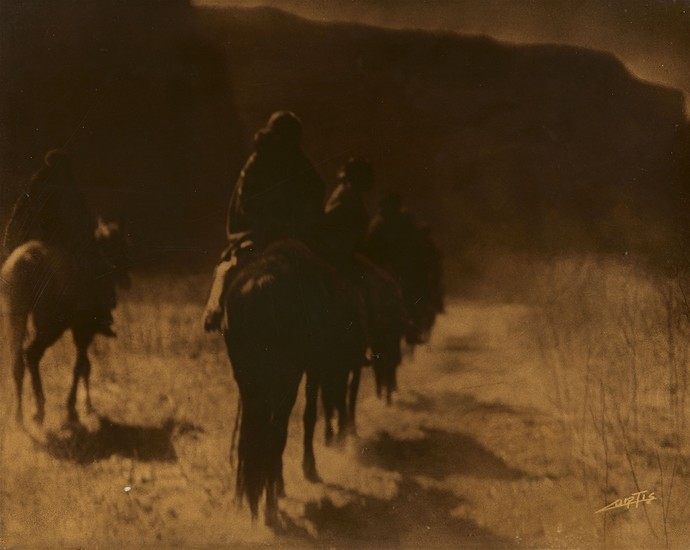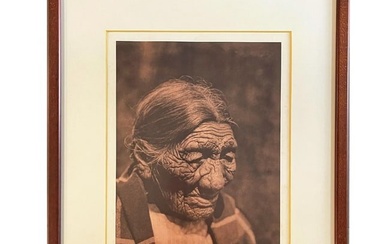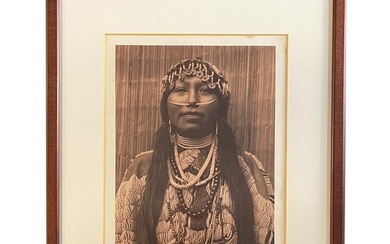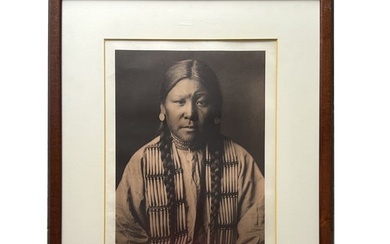Edward S. Curtis, The Vanishing Race
Edward S. Curtis
Wisconsin 1868 - 1952 Los Angeles
The Vanishing Race
1904
Orotone print. 27.8 x 35.4 cm. Signed in the negative lower right. - Small loss lower left. In wooden frame (old). Provenance
Private collection, The Netherlands Literature
Edward S. Curtis, The North American Indian, Vol. 1: The Apache. The Jicarillas. The Navaho, Cambridge 1907, plate 1; Florence Curtis Graybill/Victor Boesen (ed.), Ein Denkmal für die Indianer. Edward Sheriff Curtis und sein photographisches Werk über die Indianer Nordamerikas 1907-1930, Munich 1979, ill. p. 25; Christopher Cardozo (ed.), Native Nations. First Americans as seen by Edward S. Curtis, Boston i.a. 1993, ill. pp. 122; Christopher Cardozo, Edward S. Curtis. The Great Warriors, New York i.a. 2004, ill. p. 7; Hans Christian Adam, Edward Sheriff Curtis. 1868-1952, Cologne i.a. 2004, ill. p. 61; Joanna Cohan Scherer, Edward Sheriff Curtis, London i.a. 2008, ill. pp. 44 (each variants)
When Curtis began to take an interest in the lives of the North American natives around 1890, the expulsion of most of the Indians from their tribal areas was long over. At the beginning of the 20th century, the interest in ethnography and the 'noble savages, as whom the Indians were now seen in American society, rose notably. Apparently, the pictorial view of the photographer corresponded with the romantic needs of an audience that knew the 'Wild West' only from books. Curtis' idea of capturing the life and attestations of all Indian tribes in North America in a broadly laid out, multi-volume opus developed around 1903 and complied with his wish to establish a memorial to the North American Indians and to prevent their culture from being forgotten. The encyclopaedia 'The North American Indian' was published in 20 individual volumes between 1907 and 1930. President Theodor Roosevelt pertained to the most prominent sponsors of the project.
The vanishing race, a motif that apparently played a key role for Curtis and which he therefore used as the first plate in the first volume of his encyclopaedia, shows the romanticised perception of Curtis' early photographs, which later gave way to a more sober, documentary view. One sees a picturesquely conceived group of Indians riding away in the evening sun and thus literally - as the title says - disappearing from view. In contrast to the photogravure used in the publication, this print was a warm-toned Orotone print or Curt-Tone print (Curtis names the process he developed after himself). This is a process related to the ambrotype, in which a large-format glass positive was produced, to which an emulsion of banana oils and bronze powder was then applied to create a particular effect of depth. Curtis offered these prints, which were much appreciated for their noble golden tone and metallic sheen, in various sizes. These are unique works, which were only ever sold framed because of their sensitivity.
View it on
Estimate
Time, Location
Auction House
Edward S. Curtis
Wisconsin 1868 - 1952 Los Angeles
The Vanishing Race
1904
Orotone print. 27.8 x 35.4 cm. Signed in the negative lower right. - Small loss lower left. In wooden frame (old). Provenance
Private collection, The Netherlands Literature
Edward S. Curtis, The North American Indian, Vol. 1: The Apache. The Jicarillas. The Navaho, Cambridge 1907, plate 1; Florence Curtis Graybill/Victor Boesen (ed.), Ein Denkmal für die Indianer. Edward Sheriff Curtis und sein photographisches Werk über die Indianer Nordamerikas 1907-1930, Munich 1979, ill. p. 25; Christopher Cardozo (ed.), Native Nations. First Americans as seen by Edward S. Curtis, Boston i.a. 1993, ill. pp. 122; Christopher Cardozo, Edward S. Curtis. The Great Warriors, New York i.a. 2004, ill. p. 7; Hans Christian Adam, Edward Sheriff Curtis. 1868-1952, Cologne i.a. 2004, ill. p. 61; Joanna Cohan Scherer, Edward Sheriff Curtis, London i.a. 2008, ill. pp. 44 (each variants)
When Curtis began to take an interest in the lives of the North American natives around 1890, the expulsion of most of the Indians from their tribal areas was long over. At the beginning of the 20th century, the interest in ethnography and the 'noble savages, as whom the Indians were now seen in American society, rose notably. Apparently, the pictorial view of the photographer corresponded with the romantic needs of an audience that knew the 'Wild West' only from books. Curtis' idea of capturing the life and attestations of all Indian tribes in North America in a broadly laid out, multi-volume opus developed around 1903 and complied with his wish to establish a memorial to the North American Indians and to prevent their culture from being forgotten. The encyclopaedia 'The North American Indian' was published in 20 individual volumes between 1907 and 1930. President Theodor Roosevelt pertained to the most prominent sponsors of the project.
The vanishing race, a motif that apparently played a key role for Curtis and which he therefore used as the first plate in the first volume of his encyclopaedia, shows the romanticised perception of Curtis' early photographs, which later gave way to a more sober, documentary view. One sees a picturesquely conceived group of Indians riding away in the evening sun and thus literally - as the title says - disappearing from view. In contrast to the photogravure used in the publication, this print was a warm-toned Orotone print or Curt-Tone print (Curtis names the process he developed after himself). This is a process related to the ambrotype, in which a large-format glass positive was produced, to which an emulsion of banana oils and bronze powder was then applied to create a particular effect of depth. Curtis offered these prints, which were much appreciated for their noble golden tone and metallic sheen, in various sizes. These are unique works, which were only ever sold framed because of their sensitivity.







